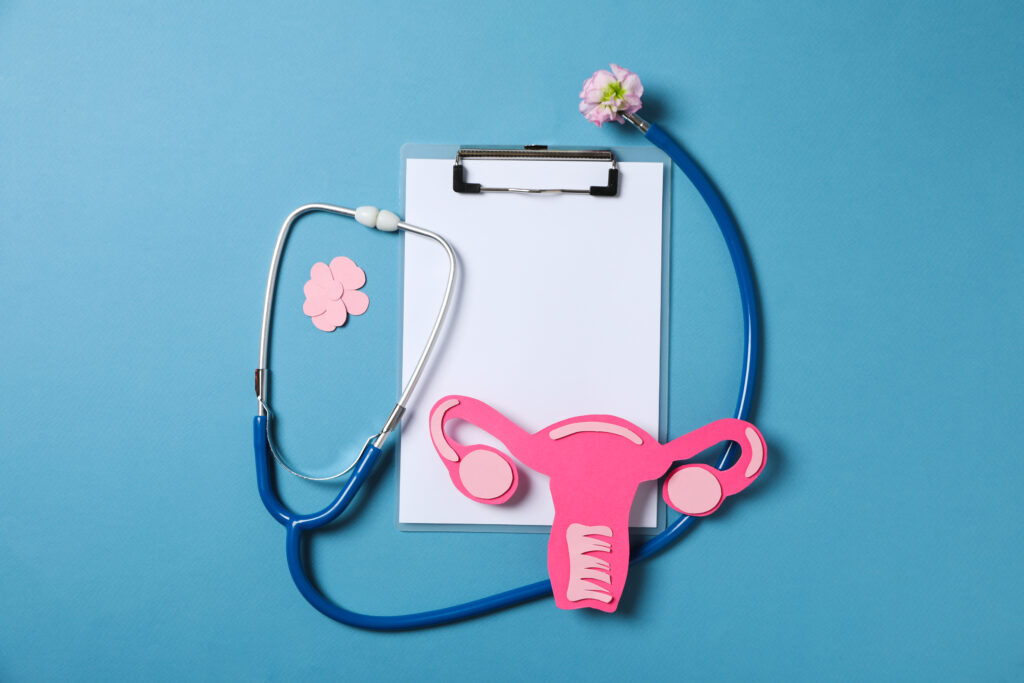
Endometriosis is a condition where tissue similar to the lining of your uterus starts to grow outside your uterine cavity, on your ovaries, bowel, and tissues lining your pelvis. The normal lining inside your uterus is called the endometrium, and when the tissue grows outside of the uterus, it’s known as an endometrial implant.
Although this endometrial-like tissue is not cancerous, it can lead to pain, scarring, and adhesions. It may also block the fallopian tubes and form cysts due to the trapped blood. Sometimes, tissues can fuse, which can lead to changes in the reproductive organs.
Read on to find out all about endometriosis, risk factors, symptoms, diagnosis, and treatment options available.
Risk Factors
Certain factors can often increase the risk of developing endometriosis. These include:
- Having a close family member (like a parent, sibling, or aunt) with endometriosis
- Having a low body mass index (BMI)
- Having short menstrual cycles (less than 28 days between your periods)
- Experiencing heavy periods that last longer than a week
- Starting your periods at a very young age
- Going through menopause at an older age
- Have never given birth
- Having high levels of estrogen
- Having a medical condition that affects normal blood flow during your period
Symptoms
The symptoms of endometriosis can often vary. Some may only have mild symptoms, while others experience more moderate to severe symptoms. You might even not have any symptoms at all. However, the severity of your pain doesn’t necessarily indicate the degree or stage of the condition.
Pelvic pain is a very common symptom of endometriosis. You may also have:
- Painful periods (dysmenorrhea) and cramps 1 or 2 weeks around menstruation
- Heavy menstrual bleeding or bleeding between periods
- Difficulty getting pregnant (infertility)
- Pain during sexual intercourse
- Pain and discomfort with bowel movements or during urination
- Lower back pain that can happen at any time during your menstrual cycle
- Other symptoms like fatigue, diarrhea, constipation, bloating, or nausea are also common before or during menstrual periods.
For these reasons, regular gynecological check-ups are very important. They will help your gynecologist monitor any changes, which is especially important if you have two or more of these symptoms.
Diagnosis
It’s important to understand that the process of diagnosing endometriosis can vary. According to a 2013 report, it can take an average of 6.7 years to get an accurate diagnosis of endometriosis. Be patient with yourself and the diagnostic process as you work with your healthcare team.
Your doctor will likely perform one or more of the following tests:
Detailed History
Your doctor will want to know about your current symptoms and your personal or family history of endometriosis. A general health assessment can also be conducted to check for any other signs of a chronic condition that you may have.
Physical Exam
During a pelvic exam, your doctor will use a speculum and a light to examine the inside of your vagina and cervix. They will also manually feel your abdomen to check for any cysts or scars that may be present behind the uterus.
Ultrasound
Your doctor might also use a transvaginal or an abdominal ultrasound to look for cysts related to endometriosis, but these tests may not be very effective in confirming endometriosis.
Laparoscopy
The only reliable way to identify endometriosis is through a minor surgical procedure called laparoscopy. If endometriosis is confirmed with laparoscopy, the tissue can be removed in the same procedure as well.
Treatment Options Available
Endometriosis has no cure, but various treatment options are available that help manage the symptoms. They include:
Pain Relief
Certain over-the-counter medications like nonsteroidal anti-inflammatory drugs (ibuprofen) and drugs to relieve painful menstruation can help manage pain. If these options do not help, your doctor may prescribe stronger medications to relieve pain.
Hormone Therapy
Taking supplemental hormones can sometimes help reduce pain and prevent the progression of endometriosis. This can also help your body regulate the monthly hormonal fluctuations that contribute to the growth of endometrial-like tissue outside the uterus.
Hormonal Contraceptives
Hormonal contraceptives reduce fertility by preventing the monthly growth and buildup of tissue similar to the endometrium. Birth control pills, patches, and vaginal rings may be suggested to alleviate or even eliminate pain in cases of less severe endometriosis.
Gonadotropin-Releasing hormone (GnRH)
In some cases, doctors might recommend gonadotrophin-releasing hormone treatments, which block the production of estrogen and help reduce the growth of unwanted tissue. However, they can’t repair adhesions or improve fertility.
Conservative Surgery
Conservative surgery is often recommended for those who want to get pregnant or suffer from severe pain that hormonal treatments cannot treat. Laparoscopy is a minimally invasive surgery used to diagnose and look for endometriosis. This procedure is also used to remove the abnormal or misplaced endometrial-like tissue.
Hysterectomy
If other treatments don’t improve your condition, your doctor may recommend a total hysterectomy. In this surgery, the surgeon removes the uterus, ovaries, and cervix, as well as any visible implant lesions.
Although a hysterectomy can treat endometriosis, it is not a cure, and you won’t be able to get pregnant after the surgery. If you’re considering starting a family, it’s important to get a second medical opinion before agreeing to a hysterectomy.
Natural Remedies
Some complementary and alternative treatment options and lifestyle choices may help manage endometriosis symptoms. They include:
- Reducing fat and increasing fiber in your daily diet
- Limiting meat consumption
- Avoiding caffeine
- Trying acupuncture
- Managing your stress levels
- Working out regularly
Conclusion
Endometriosis is a chronic condition that’s idiopathic, which means, its causes are yet to be determined. As of now, there is no cure for it.
However, lifestyle changes and treatment options, such as medications, hormone therapy, and surgery, can help manage its symptoms and complications like pain and fertility issues respectively.
If you think you might have the symptoms of endometriosis, it’s important to contact your healthcare provider right away. They can help you accurately diagnose the condition and eventually create a personalized plan based on your specific situation.
Want a detailed guide to women’s health and wellness?
CLICK HERE to enroll in our Women’s Health and Wellness Course!
References:
Parasar, Parveen, Pinar Ozcan, and Kathryn L. Terry. “Endometriosis: epidemiology, diagnosis and clinical management.” Current obstetrics and gynecology reports 6 (2017): 34-41.
Kong, Sai, et al. “The complementary and alternative medicine for endometriosis: a review of utilization and mechanism.” Evidence‐Based Complementary and Alternative Medicine 2014.1 (2014): 146383.
Alimi, Yusuf, et al. “The clinical anatomy of endometriosis: a review.” Cureus 10.9 (2018).
Rogers, Peter AW, et al. “Defining future directions for endometriosis research: workshop report from the 2011 World Congress of Endometriosis in Montpellier, France.” Reproductive sciences 20.5 (2013): 483-499.
National Health Service (NHS) UK – Treatment – – – Endometriosis
https://www.nhs.uk/conditions/endometriosis/treatment/
